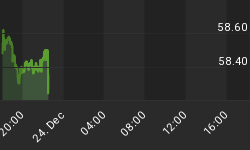Meltdown In Base Metal Prices:
-
Our index, including nickel, set its rebound high at 2449 on March 5.
-
The initial decline was to 1983 near the end of March.
-
The next rally made it to 2123 in the middle of April.
-
Today, the index was at 1754, down 3.6% from yesterday, and 9.4% from last Friday.
-
This is down 28% from the March high and decisively takes out the interim low of 1983.
-
The panic low in December was 1763. The cyclical high was 3201 in May, 2007.
* * * * *
Grain Prices Are Toast:
-
Our index of corn, wheat and soybeans set its high at 3094 at the end of February.
-
The initial slump was to 2393 on March 20.
-
The rebound made it to 2646 in the middle of April.
-
Yesterday's 2391 is down 23% from the high and at the point of failure.
* * * * *
The talking heads on TV as well as many commodity experts are still going on about soaring prices, but these two important sectors have had their blow offs and have failed.
In some cases such as copper, lead, nickel and wheat their bull markets accomplished the biggest percentage gains in over a hundred years. That is real terms as deflated by the PPI and the gains were greater, by far, than those with the typical bull market or even the best previous. Some examples follow.
The game to load up novitiates with commodities began some time ago and has come to fruition on this business cycle.
"Pork Bellies in Your Pension
"The bullish case is being vigorously espoused. Goldman Sachs...one of the loudest advocates of commodities has been urging large funds to keep 5% of their portfolios in commodities.
- Financial Times November 7, 1994
Financial institutions "investing" in commodities will eventually be seen as a great policy blunder. While a breach of fiduciary responsibility, the blunder has been in response to the most magnificent blunder in financial history - the sure thing that central bankers will be able to depreciate their currencies forever. This has been an ancient practice to serve ambitious government, and an insidious breach of accountability--otherwise known as policymaking.
When this writer started with Canada's premier investment dealer in 1963, the notion prevailing at the highest levels was that institutions should be mainly positioned in high-grade bonds. This was safe as chronic inflation was a disease that only afflicted Europe, or banana republics. This could not happen in Canada, or the US, and high-grade bonds would not increase in yield beyond 5%. The high was 15% in 1981, when bonds were universally scorned.
What asset class will fail next?
COPPER
BIGGEST BULL MARKETS SINCE 1900
(ADJUSTED BY PPI)
| Start | Peak | Gain | Subsequent Low | Year |
| 79 Nov. 2001 | 417 May 2006 | 428 % | ? ? | ? ? |
| 98 Oct. 1994 | 262 Dec. 1988 | 167 % | 79 | 2001 |
| 99 Nov. 1946 | 271 March 1956 | 174 % | 126 | 1958 |
| 98 Nov. 1920 | 245 Apr. 1929 | 150 % | 75 | 1932 |
-
This one was published in May 2006 and that high in the real price still holds.
-
The subsequent decline ran into February, 2008 and amounted to 40%.
-
The rebound in the nominal LME price made it to 403 in early April.
-
The current price is 375.
LEAD
BIGGEST BULL MARKETS SINCE 1900
(ADJUSTED FOR PPI)
| START | PEAK | GAIN | SUBSEQUENT LOW | YEAR |
| 551 Oct 2002 | 4155 Oct 2007 | 654 % | ? ? | ? ? |
| 507 March 1985 | 1,966 March 1990 | 287 % | 507 | 1993 |
| 939 Dec 1975 | 3,249 June 1979 | 277 % | 556 | 1985 |
| 739 Sept 1962 | 2,290 Feb 1965 | 210 % | 939 | 1971 |
| 517 July 1932 | 1,964 Mar 1937 | 280 % | 812 | 1938 |
| 616 Feb 1921 | 1,988 Dec 1924 | 223% | 517 | 1932 |
-
The October high still holds.
-
The initial decline into January amounted to 37%.
-
In nominal terms the October high was 3958 and the December low was 2340.
-
The rebound high was 3399 in March.
-
The current price is 1996.
CRUDE OIL
BIGGEST BULL MARKETS SINCE 1900
(DEFLATED BY PPI)
| START | PEAK | GAIN | SUBSEQUENT LOW | YEAR |
| 16.44 Dec. 1998 | 133.7 ? | 715 % | ? ? | ? ? |
| 18.91 March 1986 | 60.99 Oct. 1990 | 223 % | 15.94 | 1998 |
| 14.59 May 1973 | 82.34 March 1980 | 464 % | 18.91 | 1986 |
| 4.22 May 1933 | 18.10 Jan. 1950 | 331 % | 14.59 | 1973 |
| 6.13 May 1915 | 30.69 Dec. 1920 | 403 % | 4.22 | 1933 |
Source: TheChartStore.com
-
The table compares all of the big bull markets over the past 100 years. It does not attempt to analyse the technical or timing dynamics, but establishes perspective.
-
At +715%, this bull market has racked up the biggest gain, which is outstanding compared to the previous best at +464% to the sensational high in 1980.
-
Over the past year, similar extraordinary gains, for example, recorded by wheat, copper, lead and nickel.
-
Often crude oil can make an important seasonal high in March. If this doesn't work out there are examples of an even bigger seasonal high in May.
Link to Friday, May 23, 2008 'Bob and Phil Show' on Howestreet.com:http://www.howestreet.com/index.php?pl=/goldradio/index.php/mediaplayer/863















